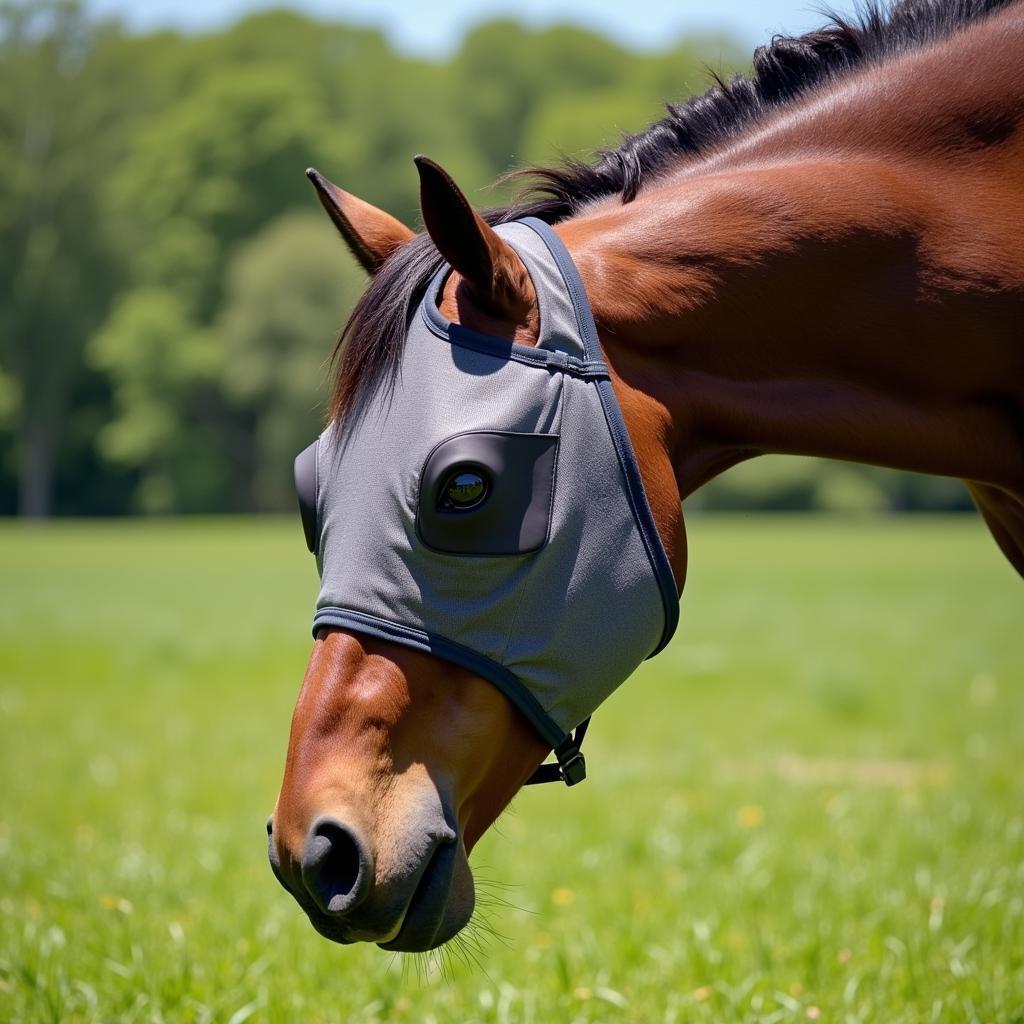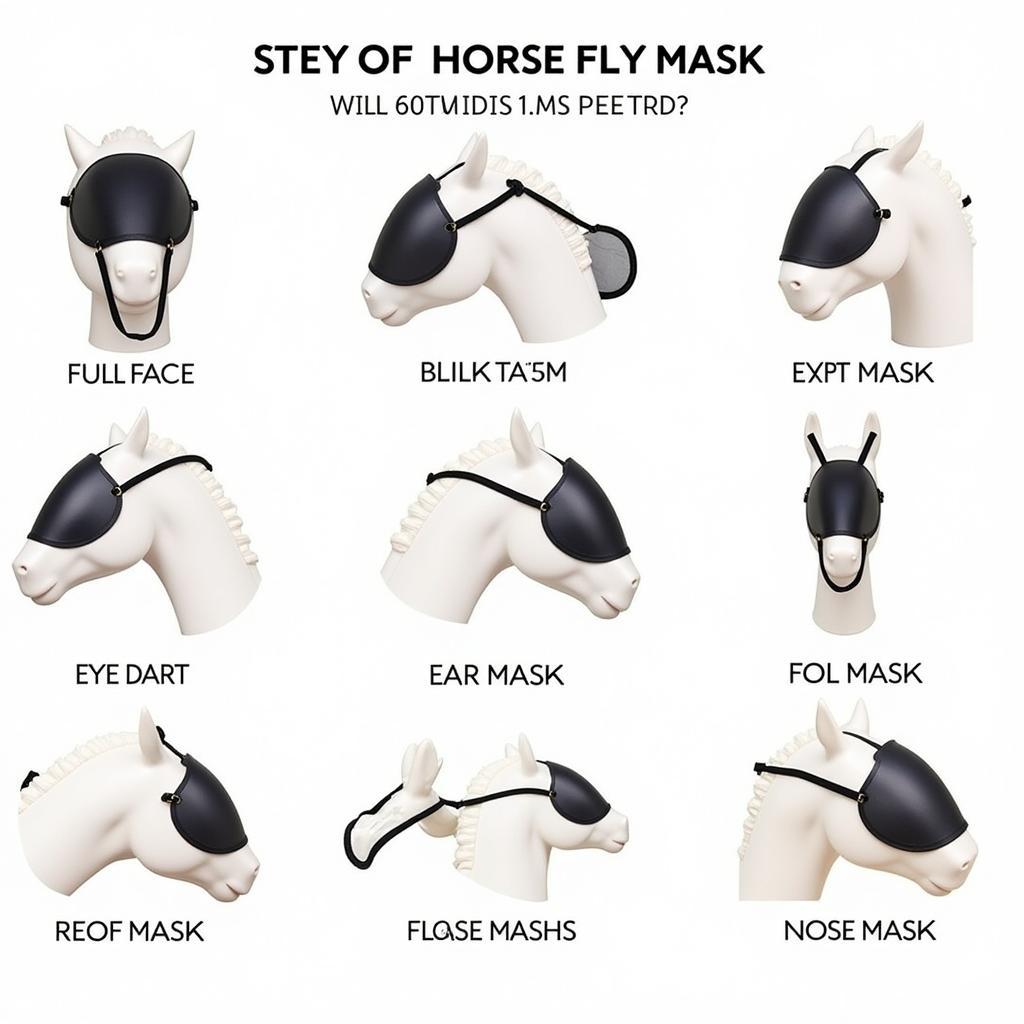Choosing the Best Fly Mask For Horses is a crucial part of responsible horse ownership. Flies aren’t just a nuisance; they can transmit diseases, cause irritation, and lead to dangerous eye infections. A good fly mask provides a barrier against these pests, offering your equine friend much-needed relief. But with so many options available, finding the perfect mask can seem overwhelming. This comprehensive guide will walk you through everything you need to know, from understanding the different types of fly masks to choosing the right size and fit for your horse.
 Horse Wearing a Fly Mask in a Pasture
Horse Wearing a Fly Mask in a Pasture
Types of Fly Masks
Just like horse riding helmets, fly masks come in various styles, each with its own advantages:
- Full-Face Masks: As the name suggests, these masks offer maximum coverage, protecting the eyes, forehead, and sometimes even the ears and nostrils. They are ideal for horses highly sensitive to flies or those in heavily infested areas.
- Eye Dart Masks: These masks feature a unique, extended piece of fabric below the eyes designed to prevent those pesky flies from darting in for a closer look.
- Ear Masks: Providing additional protection for sensitive ears, these masks are often combined with full-face or eye dart designs for comprehensive coverage.
- Nose Masks: For horses prone to sunburn or those bothered by insects around their muzzles, nose masks offer targeted protection.
 Different Types of Horse Fly Masks
Different Types of Horse Fly Masks
What to Look for in a Fly Mask
Choosing the best fly mask involves considering several factors:
- Material: Look for breathable fabrics like mesh or nylon that allow for airflow while keeping insects out. UV-resistant materials are crucial for protecting your horse’s delicate skin from harmful sun rays.
- Fit: A well-fitting mask should sit comfortably on your horse’s face without gaps or rubbing. It should be snug but not too tight, allowing for proper blinking and airflow.
- Visibility: Ensure the mask offers good visibility for your horse, especially around the periphery. Look for masks with clear or fine mesh around the eyes.
- Durability: Opt for durable materials and sturdy construction that can withstand regular wear and tear. Horses are notorious for rubbing their faces, so choosing a mask that can handle some roughhousing is essential.
Measuring for the Perfect Fit
A poorly fitting mask can cause discomfort and even injury. Follow these steps to measure your horse for a fly mask:
- Measure the Forehead: Using a flexible measuring tape, measure across your horse’s forehead, starting approximately one inch below the ears and ending at the same point on the other side.
- Measure the Cheek: Measure from the corner of your horse’s eye to the corner of its mouth.
- Consult the Size Chart: Once you have these measurements, compare them to the size chart provided by the manufacturer. Each brand may have slightly different sizing, so always double-check before purchasing.
Caring for Your Horse’s Fly Mask
Proper care can extend the life of your horse’s fly mask:
- Regular Cleaning: Rinse the mask regularly with mild soap and water to remove dirt, sweat, and debris. Allow it to air dry completely before putting it back on your horse.
- Inspect for Damage: Check the mask frequently for any tears, holes, or loose straps. Repair or replace any damaged parts immediately to ensure your horse’s safety and comfort.
Expert Insights
“Investing in a high-quality fly mask is a simple yet effective way to protect your horse’s eyes and ensure their well-being,” says Dr. Emily Carter, a renowned equine veterinarian. “Remember, a comfortable horse is a happy horse!”
Conclusion
Choosing the best fly mask for your horse doesn’t have to be complicated. By understanding the different types, features, and fitting requirements, you can find the perfect mask to provide optimal protection and comfort for your equine companion. Remember, a fly mask is an essential investment in your horse’s health and happiness.
FAQs
Q: Can my horse wear a fly mask at night?
A: While most horses don’t require a fly mask at night, it’s safe to leave it on if your horse is particularly bothered by insects or needs protection from dust and debris.
Q: How often should I clean my horse’s fly mask?
A: It’s recommended to rinse the mask daily and give it a thorough cleaning with mild soap and water at least once a week.
Q: My horse keeps rubbing its face on things with the fly mask on. What should I do?
A: Check the fit of the mask to ensure it’s not too tight or rubbing. You can also try a different style or brand to find one that suits your horse better.
If you need help choosing the right fly mask for your horse, our team at Justus Horses USA is here to help.
Contact us:
Phone Number: 0772127271
Email: [email protected]
Address: QGM2+WX2, Vị Trung, Vị Thuỷ, Hậu Giang, Việt Nam.
We have a dedicated customer support team available 24/7 to answer your questions and provide expert advice.